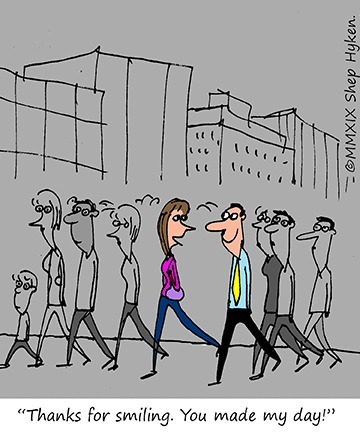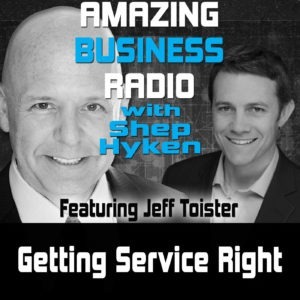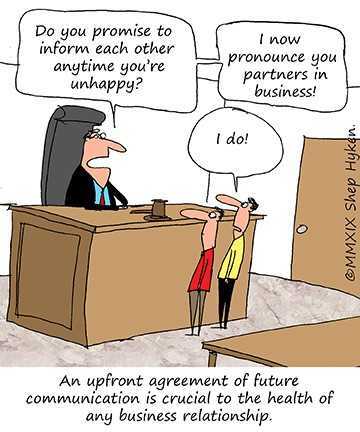Shep Hyken's Blog, page 129
April 3, 2019
The Power of a Smile
 “Smile and the world smiles with you.” That is part of a longer quote attributed to Stanley Gordon West. It became the topic of conversation while on a New York subway with my daughter, Alex, when I noticed her smile at someone who, in turn, smiled back. I complimented her on the small but kind gesture, and it started a great conversation about life and customer service.
“Smile and the world smiles with you.” That is part of a longer quote attributed to Stanley Gordon West. It became the topic of conversation while on a New York subway with my daughter, Alex, when I noticed her smile at someone who, in turn, smiled back. I complimented her on the small but kind gesture, and it started a great conversation about life and customer service.
Now, some of you may be thinking, “Big deal. It was just a smile.” But it is a big deal. Alex shared the story about where she learned about the power of a smile.
Back when Alex was a teenager, she attended the annual convention of the National Speakers Association. There was a youth program that featured the top motivational speakers in the world. One of them was my friend W Mitchell, an amazing man who has overcome incredible adversity. First, he had a motorcycle accident where his face and a good percentage of his body was burned. Then he was in a plane crash that put him a wheelchair for the rest of his life.
The way Alex remembers it, Mitchell told a story about how he didn’t want to go outside. After the motorcycle accident, he was uncomfortable about how people might react to seeing his face. One day he mustered up the courage to walk outside. He saw a little girl and was terrified he might scare her. She looked at him and smiled. He smiled back. That little girl’s smile meant the world to him.
Alex said, “After hearing his story, I started smiling and saying good morning or hello to everyone.” She told me how every day when she takes the train home from work there is a homeless man who is always asking for money. Hardly anyone looks at this man as they walk by him. Alex said that the first day she saw him she smiled and said, “Hi,” as she walked by. On that day she was wearing a coat with a leopard pattern, so the man responded, “Hello girl in the leopard coat.” Thus began a daily ritual. Every day she would smile and say hello and he would always respond the same way.
She mentioned that she does that same thing at work. As she walks by a colleague, she always smiles. She almost always gets a friendly smile back.
That day, as we were shopping, I noticed sales people that weren’t smiling or making eye contact with their customers when they walk into their stores. I couldn’t help but think of the missed opportunity to set a more positive tone and create a better human-to-human connection.
The point is that a smile is a small gesture, but a powerful one. It takes little effort and doesn’t cost anything. You just have to get in the habit of doing it. It’s powerful at work and in your personal life. When you get into the habit of smiling at others, you’ll start to notice how many people smile back at you.
Shep Hyken is a customer service expert, keynote speaker, and New York Times bestselling business author. For information, contact 314-692-2200 or www.hyken.com. For information on The Customer Focus customer service training programs, go to www.thecustomerfocus.com. Follow on Twitter: @Hyken
customer service training programs, go to www.thecustomerfocus.com. Follow on Twitter: @Hyken
The post The Power of a Smile appeared first on Shep Hyken.
April 2, 2019
Amazing Business Radio: Jeff Toister
 Getting Service Right with Guest Jeff Toister
Getting Service Right with Guest Jeff ToisterTaking Care of Your Employees So They Take Care of Customers
Shep Hyken interviews Jeff Toister. They discuss his book, Getting Service Right: Overcoming the Hidden Obstacles to Outstanding Customer Service, and Jeff offers immediately applicable advice on how to improve your customer service.








In Shep’s Opening Monologue…
He discusses the importance of caring for your employees so they can better care for your customers.
The Interview with Jeff Toister:
It’s difficult to not take angry customers personally. The instinct is either fight or flight, neither of which is helpful in a customer service situation. The key is to recognize this instinct, take a pause and a breath, and choose to respond in a different way.
Employees are trained to jump straight into offering solutions to angry customers rather than focusing on the emotions at play. Often, angry customers need to vent first. Once they’ve calmed down, they will be more receptive to your ideas for solutions to their problem.
Transform your approach from an adversarial stance to the mindset of a partner. If you approach the problem with the customer as a team, they won’t be on the defensive and will be more open to potential solutions.
Organization leaders and executives usually don’t spend much time dealing with customers and can, therefore, be out of touch with their company’s quality of customer service. They may make the mistake of assuming that customer service is both easy and common sense, which it isn’t.
People assume that customer service is getting worse when in reality, it’s getting better. The issue is that “good” customer service is what’s expected, and people remember negative experiences more because it’s a deviation from the expectation.
When you witness an employee fall short of an expectation, don’t jump straight to conclusions and solutions. Instead, ask “why?” and suspend judgment. Have a conversation with the employee and involve them in problem-solving for the present and the future.
Quotes:
“Great customer service leaders make it easy for their employees to deliver great service.” – Jeff Toister
“Find ways to make it easier for your employees to do the right thing, and chances are they will.” – Jeff Toister
About:
Jeff Toister is a top customer service and experience influencer and the author of three customer service books. He has also created video-based training courses for LinkedIn Learning (a.k.a. Lynda.com).
Shep Hyken is a customer service and experience expert, New York Times bestselling author, award-winning keynote speaker, and your host of Amazing Business Radio.
This episode of Amazing Business Radio with Shep Hyken answers the following questions … and more:
How do I deal with angry customers?
How can I improve my customer service?
Is customer service getting better or worse?
How can I motivate my employees?
How can I not take angry customers personally?
The post Amazing Business Radio: Jeff Toister appeared first on Shep Hyken.
April 1, 2019
5 Top Customer Service Articles for the Week of April 1, 2019
Each week I read a number of customer service and customer experience articles from various resources. Here are my top five picks from last week. I have added my comment about each article and would like to hear what you think too.
Customer Service Is Poised for an AI Revolution by Vala Afshar
(ZDNet) AI is viewed by customer service decision makers and agents alike as a boon to the customer and employee experience. AI adoption is nascent, but it’s set to soar as more teams turn to chatbots, text, and voice analytics, and other use cases.
My Comment: Are you ready for the AI Revolution? Use of AI in customer service is predicted to increase by 143 percent over the next 18 months. It’s only going to get better. My friend, colleague and brilliant businessman, Vala Afshar, shares his insights on one of the most important trends in customer service.
A Complete Guide to Social Media Customer Service by Anna Bredava
(Search Engine Journal) In this article, we’ll go through all the steps of building a social customer service strategy from scratch and answer the frequently asked questions about social customer support.
My Comment: The title of this article is “A Complete Guide to Social Media Customer Service.” I’ll argue that it is not a “complete guide,” but it is an excellent guide, worthy of your attention. A nice article featuring some of the most relevant trends and strategies happening in social customer care.
How Customer Service Trends Are Changing in 2019: Highlights from the New State of Service Report by Sarah Patterson
(Salesforce) Today, we’re releasing a new research report that shows just how trends in customer service are evolving in this hypercompetitive customer landscape.
My Comment: Our friends at Salesforce have just released their 2019 “State of Service” report. This is a short summary with highlights of some of the most important trends. I’m betting you’ll like this information to download the full report.
If You Want to Thrive, Focus on the Customer Experience by Rhett Power
(Inc.) To show your customers how great it is to do business with you, start by not making them wait.
My Comment: Does your online presence give your customers the experience they deserve? The speed of your website can have a dramatic impact on the customer experience – to the point that a slow website can cost you more than you think. The article points to Google research that indicates more than half of consumers will abandon your mobile website if they have to wait longer than three seconds for it to load.
Do Customers Trust Your Tech? A Look at Technology and Data Protection by Brian Hannon
(TotalRetail) While many businesses and consumers have embraced chatbots and automated features in order to make service inquiries and share personal information, the relationship between customers, chatbots and brands still needs one critical thing to work — the human touch.
My Comment: Trust is a big part of the customer experience. Regardless of how good a product or price is, if customers can’t trust the company they are doing business with, they move on. With all the data breaches and the questionable practices of some popular websites, trust in the customer experience is paramount.
Shep Hyken is a customer service expert, professional speaker and New York Times bestselling business author. For information on The Customer Focus customer service training programs go to www.TheCustomerFocus.com. Follow on Twitter: @Hyken
customer service training programs go to www.TheCustomerFocus.com. Follow on Twitter: @Hyken
The post 5 Top Customer Service Articles for the Week of April 1, 2019 appeared first on Shep Hyken.
March 29, 2019
Guest Blog: How to Boost Retail Customer Experience Through AI-powered Price Optimization
This week we feature an article by Alexandr Galkin who writes about how retail management should focus on direct communication and/or a balanced pricing strategy and allow AI to manage price optimization.
Customer experience comes first. Give buyers what they want, at the right price and time — and you’ll make them buy more and stay loyal to you. The pricing process is a crucial element in building a successful shopping journey. As PWC recent study reveals, the price is what makes consumers shop at a particular retailer; the desired item being in stock, trust to the brand and a good location come next. Artificial intelligence can help to maintain your prices right.
Using dating terms, the price of a product can be compared to the first glance at a person you like. The price should trigger further interest in the item and seem fair even long after the purchase is made. It is something the buyer looks back at to understand if the whole relationship, or customer experience, was worth it.
Customers choose retailers with optimal prices. Does an optimal price necessarily mean the lowest one? Definitely, no. The art of crafting an optimal price entails persuading customers that your prices are the best bargain in the market (Amazon is brilliant when it comes to building the right price perception) and considering hundreds of variables (customer behavior, business goals, weather, and market data, to name a few) to base your prices on.
Very often, retail managers lack time and capacity to process and take into account all the necessary data to set attractive prices. “If your product managers say they would rather use their experience to set the prices, do not believe them. Human managers cannot work better than a machine,” says Bogdan Nesterenko, Head of Cross-border Projects at Northern European omnichannel electronics retailer RD Electronics.
Maybe, they simply shouldn’t. Advanced retailers have come to a realization that their managers, or agents, should rather focus on direct communication with customers and/or a balanced pricing strategy. Technology augments their expertise by handling routine tasks, analyzing enormous amounts of data, and providing market and customer insights. Powered by machines, managers can switch to making high-level decisions and ensuring that the customer comes first in any of the retailer’s undertakings.
Businesses are embracing AI-powered price optimization. For example, Amazon generates more than 35% of its revenue via AI price recommendations. Considering, that the US giant accounted for almost half of the US e-commerce market, or $258.22 billion, in 2018, its AI-driven earnings are impressive.
What makes such price optimization efficient?
When calculating prices, AI takes into account any amount of data with any number of pricing and non-pricing parameters (which is already unyielding for managers) to forecast demand and recommend the right prices in real time. It can suggest how to build the right price perception for a particular product or group of products and persuade customers that your prices are the most optimal in the market.
Also, artificial intelligence allows retailers to test if their pricing strategies are truly customer-oriented by predicting demand. As a result, you entice more customers, and the first stage of ensuring a rewarding customer journey is complete.
All-in-all, customer experience is becoming the key business priority for many retail companies. As the price of a product remains a crucial element of a rewarding customer journey, retailers adopt innovative technologies to ensure that their prices entice customers. Many businesses turn to AI-powered price optimization as a way to factor in any number of variables when calculating prices and allow managers to focus on interactions with customers and crafting customer-oriented pricing strategies.
Alexandr Galkin, CEO & Co-founder of Competera, price optimization software for enterprise retailers looking to increase revenue and stay competitive. Forbes contributor, speaker at IRX, eCommerce, RBTE conferences.
For more articles from Shep Hyken and his guest contributors go to customerserviceblog.com.
Read Shep’s latest Forbes article: The Thinking Behind Customer Relationship Management (CRM)
The post Guest Blog: How to Boost Retail Customer Experience Through AI-powered Price Optimization appeared first on Shep Hyken.
March 27, 2019
Nobody Goes There Anymore… It’s Too Crowded
 The other day I was driving by a Chick-fil-A restaurant at lunchtime. I was blown away by how many people were in the drive-through lane. There had to be at least 20 cars. I thought to myself, “That’s a long line. You really have to love Chick-fil-A to brave that line at lunchtime.”
The other day I was driving by a Chick-fil-A restaurant at lunchtime. I was blown away by how many people were in the drive-through lane. There had to be at least 20 cars. I thought to myself, “That’s a long line. You really have to love Chick-fil-A to brave that line at lunchtime.”
Then I noticed they had four people on the lot taking orders from the people in the drive-through. They eliminated the problem. The cars were moving through the line at a pretty good speed. Actually, they moved faster than the traffic I was sitting in on the main street. Brilliant thinking… just because you’re in the drive-through lane, doesn’t mean you have wait to get to the front of the line to order.
There’s an old saying often attributed to Yogi Berra, who was known to say some pretty clever things. I believe he was referring to a restaurant when he said, “Nobody goes there anymore. It’s too crowded.” My take on this is that the place was so successful and the wait to get a table so long, people just stopped going to what was once a very popular restaurant.
I remember when Home Depot came to the St. Louis area, which is where I live. The parking lots were jammed, and the lines were long – so long that it prompted a local news station to come out and report on how long the lines were. Well, a smart manager realized he had to change this problematic reputation, so Home Depot started advertising that the lines would never be longer than five minutes. Any customers who had to wait in line longer than that would receive a discount. Problem solved. Bad reputation averted.
When your success causes your customers frustration because you are too busy to take care of them, you are at risk of losing your best customers. How often will people wait in a long line for a meal before deciding it’s not worth the time? How long will customers wait on hold for a customer service rep before switching to another brand?
There are exceptions to this. Pink’s Hot Dogs, a popular roadside restaurant in Hollywood, California, comes to mind. Its reputation for long lines is part of the experience. But those types of business are few and far between. Most of the time, you’ll frustrate customers.
If you’re so successful that you cause your customers the inconvenience of having to wait, you may be casting doubt into your customers’ minds about the next experience they are going to have with you. That’s when it’s time to get creative and find ways to create confidence, not frustration.
Shep Hyken is a customer service expert, keynote speaker, and New York Times bestselling business author. For information, contact 314-692-2200 or www.hyken.com. For information on The Customer Focus customer service training programs, go to www.thecustomerfocus.com. Follow on Twitter: @Hyken
customer service training programs, go to www.thecustomerfocus.com. Follow on Twitter: @Hyken
The post Nobody Goes There Anymore… It’s Too Crowded appeared first on Shep Hyken.
March 26, 2019
Amazing Business Radio: Natalie Petouhoff

From AI to “HIMI”
Human-Inspired Machine Intelligence
Shep Hyken interviews Dr. Natalie Petouhoff. They discuss AI in business—what works and what doesn’t work, how it can help companies and employees succeed, and how we can best utilize it. They also discuss the need for diversity and inclusiveness in the workplace.








In Shep’s Opening Monologue…
He discusses the pros and cons of chatbots.
The Interview with Natalie Petouhoff:
Companies that become too enamored with chatbots, AI, and other technologies can risk losing touch with their customers.
AI shouldn’t replace humans; it’s meant to aid and augment both the employee and customer experiences.
AI might be more useful to employees rather than customers. It can eliminate mundane, repetitive task for support center agents and help them build better rapport with their customers, which thereby improves the customer experience.
Social media has transformed how customers and businesses interact. Having multiple methods of contact, or channels, removes effort from customers, which customers really like.
Contact centers and companies alike need to reorient themselves so that the customer is at the center of their operations. They should be less concerned with statistics and more concerned with people.
You don’t have to go above and beyond to create an exceptional customer experience. Most customers simply want a quick, easy, and efficient answer or solution to their problems. Providing that is going above and beyond when that isn’t the standard.
Companies and employees need to be able to guide and train their AI so it learns better. AI is not meant to operate in an isolated environment; its intelligence is human-inspired.
Companies are no longer competing solely against their direct competitor; they’re now competing against the highest standard for service across the board. AI can help power that without customers even realizing it.
When companies don’t have an agile mindset, it can be difficult for them to adjust to how rapidly technology changes. Failing to adapt can spell doom for companies if they don’t respond with urgency and a willingness to learn.
Quotes:
“AI is meant to augment the problem-solving process.” – Dr. Natalie
“AI is a machine that’s learning, and we have to help it learn.” – Dr. Natalie
“It’s important that all team members have a chance to contribute equally. Everybody’s voice is important.” – Dr. Natalie
About:
Dr. Natalie Petouhoff is the Vice President of Customer Service Innovation at Salesforce Service Cloud. With years of experience as a contact center analyst, a customer service advisor, and more, she has authored over 150 white papers, e-books, and webinars.
Shep Hyken is a customer service and experience expert, New York Times bestselling author, award-winning keynote speaker, and your host of Amazing Business Radio.
This episode of Amazing Business Radio with Shep Hyken answers the following questions … and more:
Should I use a chatbot for my business?
What is psychological safety in a business?
How fast is technology changing?
How can I keep up with changing technology?
How important is diversity in the workplace?
The post Amazing Business Radio: Natalie Petouhoff appeared first on Shep Hyken.
March 25, 2019
5 Top Customer Service Articles for the Week of March 25, 2019
Each week I read a number of customer service and customer experience articles from various resources. Here are my top five picks from last week. I have added my comment about each article and would like to hear what you think too.
How Blending Brand And Culture Can Impact The Customer Experience by Chris Cancialosi
(Forbes) Customer experience is a memory. An impression that can stick in the mind for a minute or a lifetime. A positive experience can result in lasting loyalty, endorsement, and evangelism. A poor experience, on the other hand, can almost instantly mean the end of a brand relationship.
My Comment: A company that is known for its amazing customer service has it baked into its culture. Leadership is where it starts, and then it permeates throughout the organization. This article covers three foundations that are the root of a customer-focused culture; purpose, promise and values.
Creating a Simple and Simplified (S+S) Experience Culture: What needs to change first? by Ricardo Saltz Gulko
(Eglobalis) As the complexity of life increases, so does the value of simplicity and simplification. Exactly how much is proven by how many of us would prefer a break from making distracting and unnecessary decisions.
My Comment: I’m a big believer in the concept of a convenient and simple customer experience. (I wrote a book on it!) This article dives into the importance of the simple experience and how it can give a company a competitive advantage.
Survey: Customer experience trends 2019 by Lynne Capozzi
(ClickZ) Per a recent survey, 66% of consumers globally said: “I don’t remember when a brand experience exceeded my expectations.” Key findings from the report.
My Comment: Here are some of the latest stats and trends in the customer experience world. ClickZ commissioned a study that included responses from more than 5,000 and 500 marketers. Good information here, but it’s just the start. If you like what you read, be sure to download the rest of the report.
How do your customers know you really, really care? by Chip Bell
(Retail Customer Experience) Here are three examples of what caring looks like up close and personal.
My Comment: My fellow customer service expert and colleague, Chip Bell, shares several excellent examples about taking personalization to a higher level. Why would a customer drive almost an hour-and-a-half to get their car serviced, passing a number of competitor dealers along the way? Read this article and you’ll find out!
Customer Service Skills You Need to Master by Alex Yumashev
(CustomerThink) So as to succeed at providing excellent customer service, you need a set of skills that drive customer satisfaction. These skills are the key to making your customers happy and winning their long-term loyalty, so the skills have to be mastered by every employee who is in touch with your customers throughout their buying journey, not just the “customer success” team.
My Comment: If you want to win the customer service “game,” then you must practice the fundamentals. Here are eight areas to focus on and strengthen. The author’s closing sentence: Surpass your customers’ expectations by training your empathy muscle, planning your time, listening actively and going the extra mile.
BONUSES
Human-Centered Customer Support by HubSpot & HelpScout
(Hubspot) We’re bringing you tactics for creating a human-centered customer support strategy
My Comment: Our friends at Hubspot have just released their report on human-centered customer support. They’ve included several quotes from me – but don’t let that stop you. It’s a great report.
Live from ModernCX 2019: 3 Days of Customer Experience Takeaways by SmarterCX Team
(SmarterCX) This week at Oracle Modern Customer Experience 2019 in Las Vegas, customer experience leaders from around the globe and across industries are gathering to glean the latest in CX technologies and trends, and share success stories, tactics, and insights for improving customer experience in the coming year and beyond.
My Comment: Last week I attended the Oracle ModernCX conference in Las Vegas. Here is a great recap that also includes an interview where I talk about some trends, the balance between digital and human experiences and the importance of a convenience strategy.
Shep Hyken is a customer service expert, professional speaker and New York Times bestselling business author. For information on The Customer Focus customer service training programs go to www.TheCustomerFocus.com. Follow on Twitter: @Hyken
customer service training programs go to www.TheCustomerFocus.com. Follow on Twitter: @Hyken
The post 5 Top Customer Service Articles for the Week of March 25, 2019 appeared first on Shep Hyken.
March 22, 2019
Guest Blog: Digitizing the Customer Experience Without Losing the Customer
This week we feature an article by John Boccuzzi Jr. who argues that digital transformation is bringing customer experience to an entirely different level. – Shep Hyken
 If you had walked into a bank, clothing store or small local grocer 50 years ago, you likely would have found the manager or even the owner greeting you at the door, and the clerks may have called you by name and asked after your spouse and children. Communities were smaller, shopping was local, and technology wasn’t there to either help or confuse the customer. Some might say it was a simpler time with a more personal touch, and in some ways they would be right.
If you had walked into a bank, clothing store or small local grocer 50 years ago, you likely would have found the manager or even the owner greeting you at the door, and the clerks may have called you by name and asked after your spouse and children. Communities were smaller, shopping was local, and technology wasn’t there to either help or confuse the customer. Some might say it was a simpler time with a more personal touch, and in some ways they would be right.
However, I would argue that digital transformation is bringing customer experience to an entirely different level. Customers are really looking for “any channel” access to their favorite brands; one day they hit the brick and mortar, and the next day they access the app from their phone. That same small business of 50 years ago can now attract new customers both locally and globally and can keep in touch with loyal customers through several channels.
By the end of 2019, 2.7 billion* people will carry a smart phone that allows them to order anything, anytime, from just about anywhere.
Loved that special ice wine you enjoyed on vacation last year? Good news: order it online today and it will arrive in time for that dinner party on Friday. All this progress requires businesses to provide an “always on, always available” customer experience.
Brick and mortar shopping isn’t going away, it’s evolving to meet the needs of the digital customer who wants options to shop local and global. Today’s customer is more informed and fully expects an increasingly personalized service, despite the fact that most of their shopping is virtual. Every aspect of a customer’s interaction with a company, product, or service affects the user’s perception and loyalty; by harnessing new technologies, cutting-edge companies are changing – and improving – the way they approach customer and user experience. Lowe’s, for example, is using artificial intelligence to track in-store inventory, and “Lowebots” are helping customers navigate the store and tracking items for restocking.
The options are endless; the key is picking the ones that are the best fit for a specific business’ customer. Some businesses fall in love with a new technology before they know if it’s something their customers need or want; instead, successful businesses focus on their customers’ entire experience, then look for ways digital solutions can streamline and enhance that customer experience. This is what Carnival Cruise Lines did when they developed the Medallion fleet, a fully customized travel experience that connects passengers to the ship with small, wearable tokens. Carnival Medallions access passengers’ data stored in the cloud, so everything from their name, cabin number, passport information and on-board charges is instantly available, powering faster check-in and boarding and an easier, more efficient experience throughout the cruise.
ISG is bringing together customer experience experts from major brands including Twitter, Oshkosh, Lowes and Muck Rack for a two-day Customer and User Experience Summit, April 17 – 18 in San Francisco to explore digital transformation and the impact it can have on the customer experience. If you have time, I would encourage you to attend so you do not miss the latest insights into this incredibly timely and important conversation. Ignoring the impact that technology can have on customer experience is like ignoring the impact digital cameras can have on the film business…and we know how that story ended.
John Boccuzzi Jr. is the senior director of ISG Research, a leader in subscription research, advisory and strategy consulting services for senior business and IT executives, technology and software vendors and business / IT services providers.
For more articles from Shep Hyken and his guest contributors go to customerserviceblog.com.
Read Shep’s latest Forbes article: Using KonMari Methods To Tidy Up And Spark Joy Into Customer Service
*https://www.statista.com/statistics/3...
The post Guest Blog: Digitizing the Customer Experience Without Losing the Customer appeared first on Shep Hyken.
March 20, 2019
The Upfront Agreement of Future Communication
 Not long ago, I wrote an article that featured Todd Hopkins, CEO of Office Pride, and his concept of core values being a decision filter. I had the chance to interview him for Amazing Business Radio and he dropped another big concept on us that’s worth bringing to our followers. He talked about an agreement he makes with all his new customers and employees, an upfront agreement tied to future communication.
Not long ago, I wrote an article that featured Todd Hopkins, CEO of Office Pride, and his concept of core values being a decision filter. I had the chance to interview him for Amazing Business Radio and he dropped another big concept on us that’s worth bringing to our followers. He talked about an agreement he makes with all his new customers and employees, an upfront agreement tied to future communication.
Essentially, Todd asks his new customers to agree in writing that if there is ever an issue, problem, complaint, question – anything that impairs the customer’s experience – that they will communicate it with either Todd or another employee. The goal is to fix problems before they fester and become bigger than they need to be. Todd says, “If a customer isn’t happy, we want them to let us know. If they let us know, then we can fix it.”
That seems like common sense, but Todd knows that customers don’t always tell us when there’s a problem or issue. How many times have you wished you could be honest with someone about how you felt, but held back out of worry or fear of their reaction? This applies to both personal and professional relationships. Customers do the same thing; they keep quiet. They never say a word. Then one day they just disappear; they stop doing business with us. But we thought they were happy! They didn’t complain!
That’s why Todd has his upfront agreement. It’s in writing – in his contract. He makes it clear that when customers contact him when they’re unhappy, their problem will be taken care of with no hard feelings or defensive behavior – from either party.
Todd is emphatic about this strategy for communication, stating, “When it comes to customer service, I believe in establishing that upfront agreement. It sets you up for a beautiful relationship for years to come. Having that upfront agreement about how we’ll communicate has saved us so much heartburn.”
Not only does Todd believe this is important for customers, he also knows how effective it is for employees. The “open door” policy of communication for employees has served him well. He finds out what’s on the employee’s mind; if there is a way to work it out, they will. He fosters open dialogue that creates a positive culture for his company.
That’s the underlying lesson here – company culture. By nurturing that open workplace communication and positive company culture, Todd sets up his business for success. What’s felt on the inside of a company will radiate through to the outside. Having a solid system of communication will facilitate this flow, make everyone’s lives easier, and ensure a positive customer experience. Consider drafting an upfront agreement for your business and see how it shapes your future.
Shep Hyken is a customer service expert, keynote speaker, and New York Times bestselling business author. For information, contact 314-692-2200 or www.hyken.com. For information on The Customer Focus customer service training programs, go to www.thecustomerfocus.com. Follow on Twitter: @Hyken
customer service training programs, go to www.thecustomerfocus.com. Follow on Twitter: @Hyken
The post The Upfront Agreement of Future Communication appeared first on Shep Hyken.
March 19, 2019
Amazing Business Radio: Mark Copeman

Habits for Success
Fostering Good Customer Service Habits to Make Your Business Stand Out
Shep Hyken interviews Mark Copeman. They discuss his new book, Helpdesk Habits, which teaches employees how to turn good customer service practices into routine habits. They also talk about the importance of humanity within the employee and customer experience.








In Shep’s Opening Monologue…
He discusses if and when you should approach the CEO of a company about a problem you’ve experienced.
The Interview with Mark Copeman:
Copeman’s book is written for agents and other employees on the frontline of businesses. Its aim is to help those agents build habits that will result in excellent customer service.
One of the habits the books talks about is the “Service Recovery Paradox.” The principle here is that sometimes things will go wrong. What matters most is how you recover from and fix those problems.
If something goes wrong in the customer experience, customer loyalty will dip. However, customer loyalty will increase over time if the issue is resolved.
Copeman introduces the concept of the “Habit Loop,” which consists of three steps: trigger, routine, and reward. The most crucial step toward building a habit is reward, which must be associated with the routine.
Another habit is called “Lay It Out.” Copeman describes this as taking a little extra time to format emails so that the crucial information recipients need is easily accessible at a glance, whether by using bullet points or bold or italic text.
Copeman’s overarching theme throughout the book is “Human Customer Service.” The companies that thrive are the ones that allow and encourage their customer-facing employees to be themselves and let their personalities shine through. It takes very little effort, but the human element is what makes the biggest difference in the customer experience.
Quotes:
“Stuff goes wrong; what counts is how you fix it.” – Mark Copeman
“It is so easy to stand out as a business if you allow employees to have a personality, to be themselves, to be human and not robotic.” – Mark Copeman
About:
Mark Copeman is the founder of Wisecurve, a content and product studio. He refers to himself as a “serial entrepreneur” and just released his first book, Helpdesk Habits.
Shep Hyken is a customer service and experience expert, New York Times bestselling author, award-winning keynote speaker, and your host of Amazing Business Radio.
This episode of Amazing Business Radio with Shep Hyken answers the following questions … and more:
How do I build good work habits?
How can I improve my customer service?
What makes a good customer service agent?
How should I react to problems in my CX?
When should I take my problems to the CEO of a company?
The post Amazing Business Radio: Mark Copeman appeared first on Shep Hyken.



